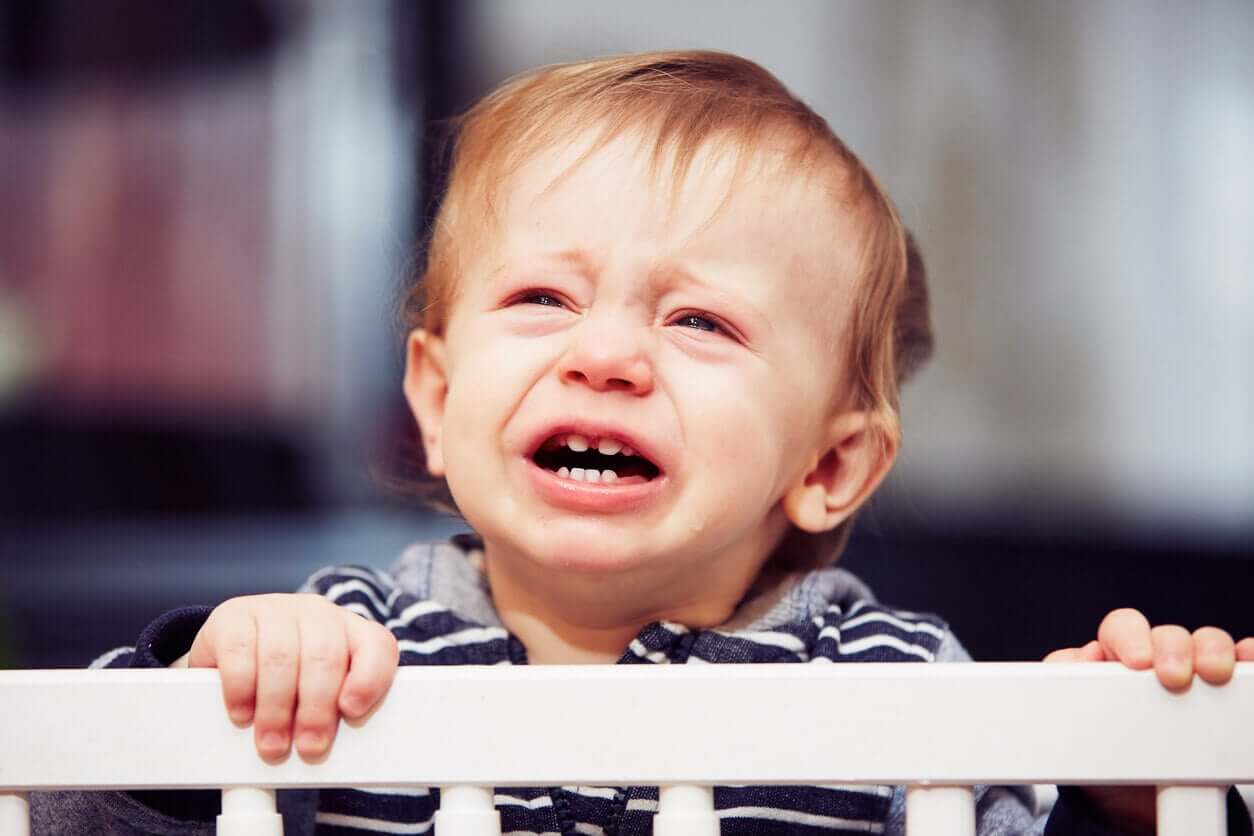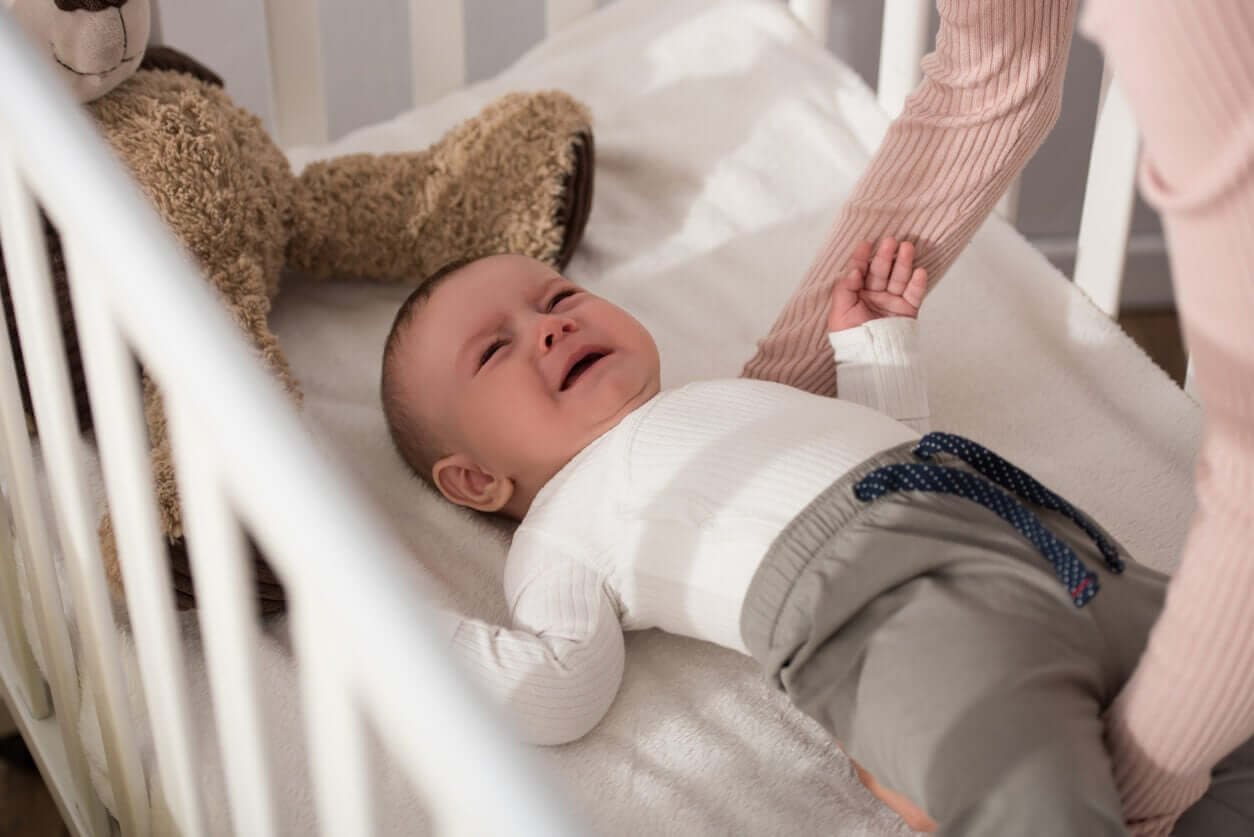My Child is Afraid of Their Crib

It’s time to sleep and, in some homes, a real battle breaks out. You probably identify with this and suspect that your child is afraid of their crib, right? If that’s the case, keep reading and find out why this happens.
Babies and fear
We have to understand that fear is a primary emotion, which alerts us to danger (real or imaginary) and allows us to take measures to make ourselves safe.
Now, if we transfer this to the life of a baby, we also have to consider the existence of evolutionary or developmental fears. That is, those that appear at different ages and are later replaced by others. With this in mind, it’s to be expected that a 12-month-old baby won’t have the same fears as a 3-year-old.
During the first years of life, the crib represents an event that causes a lot of fear and anguish in babies: The moment they go to sleep. For adults, it may be something of little significance, but for little ones, it symbolizes the disappearance of their parents and, therefore, loneliness.
For this reason, instead of ignoring this emotion, it’s essential that you accompany your child and help them to gain confidence little by little. In this way, you’ll also be able to restore calm and harmony in your home.

You may be interested in: Is It Good or Bad to Let a Baby Cry?
What to do if your child seems to be afraid of their crib?
There are some recommendations to help children overcome the fear of their crib. However, it’s always best to apply the appropriate measures to the baby that we have at home. That is, we must be respectful toward our children and not try to fit some idealized model at any cost.
Here are some tips to help you resolve this fear:
Don’t let them cry!
Many people repeat this phrase like a mantra: “Let him cry it out and they’ll get used to it”. However, there are things you should know before doing so.
Although it’s true that, after a while, the baby gets used to it, the message that their brain receives is that there’s no one who can take care of them, and, therefore, there’s no sense in crying. In addition, this learning doesn’t occur in a healthy way. Rather, it’s is fraught with anguish and discomfort.
When a baby cries, they’re trying to communicate a need. Not tending to this need is going against the bond of attachment that helps you feel safe and secure.
Therefore, not only does the relationship with their caregivers deteriorate, but the feeling of abandonment is enhanced, along with the fear of their crib.
Be patient and accompany them in the process
In the case in which you decide to follow any recommendation to help them sleep, remember to take measures gradually and accompany your child at all times. Don’t rush, because forcing your baby’s timing doesn’t always lead to better results.
For example, you can try leaving them in the crib for a few minutes during the day so that they start to get to know and familiarize themself with it. In the meantime, stay by their side so that they feel safe and gain confidence. Little by little, try to leave it for a longer time and try doing it at night as well.
In turn, try to make your child associate the crib with something positive, such as their favorite doll, a blanket, or another object of attachment.
Check your baby’s sleeping habits
There are some practices that promote good sleep and are known as sleep hygiene. Among them, adapting the physical environment in which the crib is located (lighting, temperature, and the colors of the room) or establishing routines and schedules.
Identify the baby’s sleep phases

Many times, your baby falls asleep in your arms and you immediately try to place them in their crib. Then, they wake up and everything starts over. But who wouldn’t wake up? Your arms and human warmth are so much better than a crib!
This happens because the first 20 minutes after falling asleep coincide with the light sleep phase. Therefore, at the slightest change in environment, the baby wakes up.
Therefore, it’s better to wait a little longer before trying to leave them in the crib so that they enter the deep sleep phase.
Read more: How Do Babies’ Sleep Patterns Evolve as They Grow?
Heed the call when I wake up
Has it ever happened to you to wake up disoriented and feel upset because you don’t know where you are? The same thing happens to your child when they fall asleep in your arms and wake up in their crib. Therefore, once you’ve managed to leave them there, return each time they call in order to reinforce the idea that you haven’t abandoned them.
Teach them to fall asleep
To put a baby to sleep, it’s also good to use certain strategies, such as singing softly, caressing them, or rocking them.
Although many people believe that this is counterproductive, the truth is that, through these habits, you teach them alternatives to relax, which they can then repeat on their own.
Don’t be surprised if you hear them sing softly or whisper to themself to calm down.
Keep reading: 6 Mistakes We Make Putting a Child to Bed
There’s no single recipe, much less magic
In the world of parenting, there’s always good advice and good intentions. All the people in your environment who’ve already had the experience will try to share what’s worked for them with other children. This can sometimes be a source of relief and support, but it can also create guilt.
In addition, there are certain practices that we can’t carry out for different personal reasons. Therefore, in raising children, it’s important to build one’s own parental styles, without thinking that there are universal and infallible recipes.
Each family is unique and each mother, father, and child is different from others. The key is to get in sync so that life at home flows in harmony.
The most important thing when raising a child is to be guided by empathy, respect, and understanding. To know what’s most suitable for each child, you have to know each other well enough, and this requires time and great sensitivity on the part of the parents.
Finally, look for quality information regarding the development of babies’ sleep in order to make conscious decisions on the subject.
It’s time to sleep and, in some homes, a real battle breaks out. You probably identify with this and suspect that your child is afraid of their crib, right? If that’s the case, keep reading and find out why this happens.
Babies and fear
We have to understand that fear is a primary emotion, which alerts us to danger (real or imaginary) and allows us to take measures to make ourselves safe.
Now, if we transfer this to the life of a baby, we also have to consider the existence of evolutionary or developmental fears. That is, those that appear at different ages and are later replaced by others. With this in mind, it’s to be expected that a 12-month-old baby won’t have the same fears as a 3-year-old.
During the first years of life, the crib represents an event that causes a lot of fear and anguish in babies: The moment they go to sleep. For adults, it may be something of little significance, but for little ones, it symbolizes the disappearance of their parents and, therefore, loneliness.
For this reason, instead of ignoring this emotion, it’s essential that you accompany your child and help them to gain confidence little by little. In this way, you’ll also be able to restore calm and harmony in your home.

You may be interested in: Is It Good or Bad to Let a Baby Cry?
What to do if your child seems to be afraid of their crib?
There are some recommendations to help children overcome the fear of their crib. However, it’s always best to apply the appropriate measures to the baby that we have at home. That is, we must be respectful toward our children and not try to fit some idealized model at any cost.
Here are some tips to help you resolve this fear:
Don’t let them cry!
Many people repeat this phrase like a mantra: “Let him cry it out and they’ll get used to it”. However, there are things you should know before doing so.
Although it’s true that, after a while, the baby gets used to it, the message that their brain receives is that there’s no one who can take care of them, and, therefore, there’s no sense in crying. In addition, this learning doesn’t occur in a healthy way. Rather, it’s is fraught with anguish and discomfort.
When a baby cries, they’re trying to communicate a need. Not tending to this need is going against the bond of attachment that helps you feel safe and secure.
Therefore, not only does the relationship with their caregivers deteriorate, but the feeling of abandonment is enhanced, along with the fear of their crib.
Be patient and accompany them in the process
In the case in which you decide to follow any recommendation to help them sleep, remember to take measures gradually and accompany your child at all times. Don’t rush, because forcing your baby’s timing doesn’t always lead to better results.
For example, you can try leaving them in the crib for a few minutes during the day so that they start to get to know and familiarize themself with it. In the meantime, stay by their side so that they feel safe and gain confidence. Little by little, try to leave it for a longer time and try doing it at night as well.
In turn, try to make your child associate the crib with something positive, such as their favorite doll, a blanket, or another object of attachment.
Check your baby’s sleeping habits
There are some practices that promote good sleep and are known as sleep hygiene. Among them, adapting the physical environment in which the crib is located (lighting, temperature, and the colors of the room) or establishing routines and schedules.
Identify the baby’s sleep phases

Many times, your baby falls asleep in your arms and you immediately try to place them in their crib. Then, they wake up and everything starts over. But who wouldn’t wake up? Your arms and human warmth are so much better than a crib!
This happens because the first 20 minutes after falling asleep coincide with the light sleep phase. Therefore, at the slightest change in environment, the baby wakes up.
Therefore, it’s better to wait a little longer before trying to leave them in the crib so that they enter the deep sleep phase.
Read more: How Do Babies’ Sleep Patterns Evolve as They Grow?
Heed the call when I wake up
Has it ever happened to you to wake up disoriented and feel upset because you don’t know where you are? The same thing happens to your child when they fall asleep in your arms and wake up in their crib. Therefore, once you’ve managed to leave them there, return each time they call in order to reinforce the idea that you haven’t abandoned them.
Teach them to fall asleep
To put a baby to sleep, it’s also good to use certain strategies, such as singing softly, caressing them, or rocking them.
Although many people believe that this is counterproductive, the truth is that, through these habits, you teach them alternatives to relax, which they can then repeat on their own.
Don’t be surprised if you hear them sing softly or whisper to themself to calm down.
Keep reading: 6 Mistakes We Make Putting a Child to Bed
There’s no single recipe, much less magic
In the world of parenting, there’s always good advice and good intentions. All the people in your environment who’ve already had the experience will try to share what’s worked for them with other children. This can sometimes be a source of relief and support, but it can also create guilt.
In addition, there are certain practices that we can’t carry out for different personal reasons. Therefore, in raising children, it’s important to build one’s own parental styles, without thinking that there are universal and infallible recipes.
Each family is unique and each mother, father, and child is different from others. The key is to get in sync so that life at home flows in harmony.
The most important thing when raising a child is to be guided by empathy, respect, and understanding. To know what’s most suitable for each child, you have to know each other well enough, and this requires time and great sensitivity on the part of the parents.
Finally, look for quality information regarding the development of babies’ sleep in order to make conscious decisions on the subject.
All cited sources were thoroughly reviewed by our team to ensure their quality, reliability, currency, and validity. The bibliography of this article was considered reliable and of academic or scientific accuracy.
- Nerín, N. F., Nieto, M. Á. P., & de Dios Pérez, M. J. (2014). Relación entre los estilos de crianza parental y el desarrollo de ansiedad y conductas disruptivas en niños de 3 a 6 años. Revista de Psicología Clínica con niños y adolescentes, 1(2), 149-156.
- Van IJzendoorn, M. (2010). El apego durante los primeros años (0-5) y su impacto en el desarrollo infantil. Enciclopedia sobre el desarrollo en primera infancia. [Internet] Disponible en: https://www.enciclopedia-infantes.com/apego/segun-los-expertos/el-apego-durante-los-primeros-anos-0-5-y-su-impacto-en-el-desarrollo.
- Bilbao Alvaro. (2017). Todos a la cama. Editorial Planeta. Madrid
- Pierucci, N. A., & Luna, B. K. P. (2003). Relación entre estilos parentales, estilos de apego y bienestar psicológico. Psicología y Salud, 13(2), 215-225.
This text is provided for informational purposes only and does not replace consultation with a professional. If in doubt, consult your specialist.








